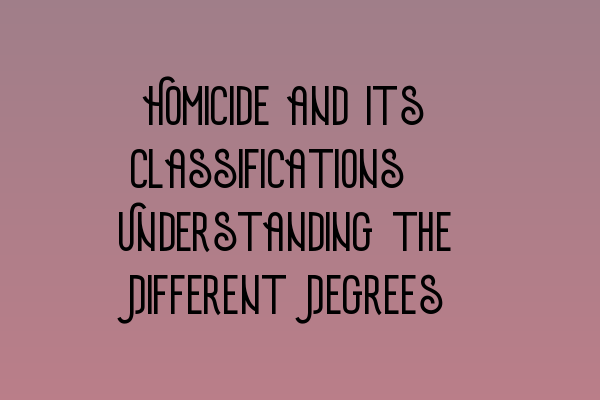Homicide and its Classifications: Understanding the Different Degrees
Welcome to SQE Criminal Law & Practice Law UK, your trusted source for legal insights and exam preparation. In this comprehensive guide, we will delve into the intricate details of homicide and its various classifications.
What is Homicide?
Homicide refers to the act of unlawfully causing the death of another person. It is a serious crime that carries severe penalties, as it involves the ultimate deprivation of someone’s life. Understanding the different degrees of homicide is crucial for legal professionals, law students, and anyone interested in criminal law.
Classifications of Homicide
1. Murder:
Murder is the most severe form of homicide, characterized by the intentional and premeditated killing of another person. It involves malice aforethought, which means the perpetrator had the intent to cause serious harm or death to the victim.
In some jurisdictions, murder is further classified into first degree and second degree murder:
- First Degree Murder: This involves deliberate planning and premeditation. It usually carries the harshest penalties, such as life imprisonment or the death penalty.
- Second Degree Murder: While still intentional, second degree murder lacks the element of premeditation. Penalties for second degree murder are generally less severe compared to first degree murder.
2. Manslaughter:
Manslaughter refers to the act of unlawfully causing the death of another person, but without the element of malice aforethought present in murder cases. It can be categorized into two main types:
- Voluntary Manslaughter: This involves the intentional killing of another person, but without premeditation. Typically, it occurs in the heat of the moment, often due to sudden provocation or extreme emotional distress.
- Involuntary Manslaughter: Involuntary manslaughter occurs when a person unintentionally causes the death of another person through reckless or negligent behavior. It lacks the intent to cause harm but involves a disregard for human life.
SQE Criminal Law & Practice Resources
For those preparing for the SQE 1 or SQE 2 exams, we provide a range of valuable resources:
- Take a look at our SQE 1 Practice Exam Questions to test your knowledge and assess your readiness.
- Benefit from our SQE 1 Practice Mocks FLK1 FLK2 to experience exam-like conditions and enhance your performance.
- Explore our comprehensive SQE 2 Preparation Courses to master the knowledge and skills required for success.
- Get a head start with our specialized SQE 1 Preparation Courses, tailored specifically for aspiring legal professionals.
- Stay updated with the latest SRA SQE Exam Dates to plan your study schedule effectively.
Conclusion
Homicide is a serious crime with various degrees of classification that determine the severity of the offense and the corresponding penalties. Understanding the differences between murder and manslaughter is essential for anyone involved in the legal field. At SQE Criminal Law & Practice Law UK, we are committed to providing comprehensive resources to help you succeed in your legal career.
For more information and exam preparation materials, visit our website and explore the related articles mentioned above. Together, let’s build a strong foundation in criminal law and practice.
